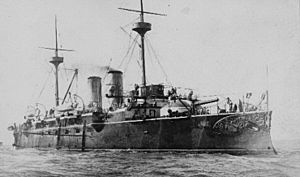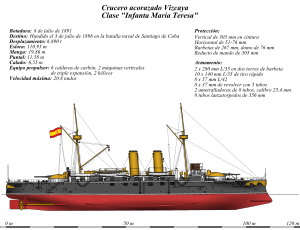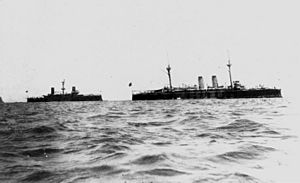Spanish cruiser Vizcaya facts for kids
class="infobox " style="float: right; clear: right; width: 315px; border-spacing: 2px; text-align: left; font-size: 90%;"
| colspan="2" style="text-align: center; font-size: 90%; line-height: 1.5em;" | 
|} Vizcaya was a powerful warship called an armored cruiser. She belonged to the Spanish Navy. She was part of the Infanta Maria Teresa class of ships. Vizcaya is famous for fighting in the Battle of Santiago de Cuba during the Spanish–American War.
Contents
- Building and Features of the Vizcaya
- Vizcaya's Journey and Battles
- The Blockade of Santiago de Cuba
- The Battle of Santiago de Cuba
- Images for kids
- Remembering Vizcaya
- See also
Building and Features of the Vizcaya
A drawing of Vizcayain 1898.
Vizcaya(on the right) and her sister ship, the armored cruiser Cristóbal Colón, at São Vicentein 1898.
Vizcaya was built in Bilbao, Spain. Her construction started in 1889. She was launched into the water on July 8, 1891, and finished in 1893. She had two tall funnels. She was designed to be fast and carried many weapons.
Her biggest guns were placed in the middle of the ship, one at the front and one at the back. However, her armor was not very strong. Her largest guns had only light protection. Smaller guns were out in the open on the top deck. Her main armor belt was thin and covered only part of the ship. Also, a large part of her side was not protected by armor. This part got a lot of damage during the Battle of Santiago de Cuba.
Like many warships from the 1800s, Vizcaya had a lot of wood inside. This wood was used for furniture and decorations. The Spanish navy did not remove this wood before battle. This later caused big fires during the battle.
Vizcaya's Journey and Battles
Vizcaya was visiting New York City in the United States. This visit was a friendly gesture. It was a return visit after the American battleship USS Maine visited Havana, Cuba. But on February 15, 1898, the Maine exploded and sank in Havana.
After the Maine sank, Vizcaya sailed to Havana. There, she met her sister ship Almirante Oquendo. As war seemed likely, both ships were ordered back across the Atlantic Ocean. They joined the Spanish Navy's 1st Squadron. This squadron was gathering at São Vicente in the Cape Verde Islands. They arrived there on April 19, 1898.
It was clear that Vizcaya needed repairs. Her bottom was very dirty, which made her slower. Some of her guns had problems, and their ammunition was faulty. The fleet also did not have enough sailors to work the ship's engines.
The Spanish–American War began while Vizcaya was at São Vicente. Portugal, where São Vicente is located, was neutral. International law said the Spanish ships had to leave within 24 hours. So, Vizcaya and the rest of the squadron left on April 29, 1898. They were heading for San Juan, Puerto Rico.
On May 10, 1898, the ships reached Martinique. This island was owned by France. France was also neutral and would not give them coal. So, the squadron left on May 12, 1898. They sailed to Curaçao, which was owned by the Netherlands. The Netherlands was also neutral. They only allowed Vizcaya and her sister ship Infanta Maria Teresa to enter port. They could only load 600 tons of coal.
On May 15, the ships left Curaçao. They changed their plan. They would not go to San Juan, as it was now blocked by the U.S. Navy. Instead, they sailed to Santiago de Cuba in Cuba. They arrived there on May 19, 1898. The Spanish commander hoped to fix his ships there. But an American squadron arrived on May 27, 1898. They started a blockade that lasted 37 days.
The Blockade of Santiago de Cuba
During the blockade, some fighting happened. On June 3, 1898, the U.S. Navy tried to block the harbor entrance. They used a ship called USS Merrimac. The plan was to sink Merrimac in the channel. This would trap the Spanish ships inside.
Spanish shore batteries fired at Merrimac. They damaged her before she reached the best spot. Vizcaya, along with other Spanish ships, also fired. Merrimac quickly sank. But she did not block the entrance. Vizcaya hit Merrimac's bridge with some of her 5.5-inch shells.
The blockade continued. Vizcaya and the other ships faced occasional American bombardments. Vizcaya still had two 5.5-inch guns that did not work. Most of her 5.5-inch ammunition was bad. Her dirty bottom could not be cleaned while trapped. Some of her crew joined a special Naval Brigade. They fought on land against the U.S. Army advancing toward Santiago de Cuba.
The Battle of Santiago de Cuba
By early July 1898, the American army was close to capturing Santiago de Cuba. The Spanish commander decided his ships had only one choice. They had to try to escape into the open sea. The escape was planned for July 3, 1898. On July 2, Vizcaya's crew returned from land duty. They prepared for battle.
Vizcaya was to be the second ship in line during the escape. She would follow the commander's ship, Infanta Maria Teresa. The plan was for Infanta Maria Teresa to attack the fastest American ship, the armored cruiser USS Brooklyn. This would give Vizcaya and the other ships a chance to speed away to the west.
Around 8:45 AM on July 3, 1898, the Spanish ships started moving. The U.S. squadron saw them in the channel around 9:35 AM. The Battle of Santiago de Cuba began.
Vizcaya followed Infanta Maria Teresa closely. Infanta Maria Teresa charged toward Brooklyn as if to ram her. When Brooklyn turned away, Vizcaya and Infanta Maria Teresa turned west. They passed the last small American ship, the armed yacht USS Vixen.
Vizcaya was now second in line. She was behind Infanta Maria Teresa and ahead of Cristóbal Colón and Almirante Oquendo. At 10:35 AM, the damaged Infanta Maria Teresa was forced to run ashore. Soon after, Almirante Oquendo also ran aground near Vizcaya. The two Spanish destroyers also sank. By 10:50 AM, only Vizcaya and Cristóbal Colón were left.
Brooklyn then focused on Vizcaya. She got very close, firing many 8-inch and 5-inch shells. American battleships like USS Texas, Iowa, Oregon, and Indiana also hit Vizcaya. Vizcaya managed to hit Brooklyn twice. These hits killed one American sailor, the only American death in the battle.
But around 11:00 AM, Brooklyn hit Vizcaya with two 8-inch shells. One hit caused a torpedo in her front tube to explode. This blew off a large part of her bow. The other hit destroyed her bridge. It also set her wooden decorations and furniture on fire. When the fire caused ammunition to explode, it was clear Vizcaya's end was near. At 11:06 AM, she turned toward the shore. She lowered her battle flag and ran herself onto the beach.
Some of her sailors made it to shore. But they had to be careful of Cuban rebels, who were shooting at the Spanish survivors. Other sailors were rescued by American sailors. They used small boats to pick up survivors from the burning wrecks. One person rescued was Vizcaya's captain, Don Antonio Eulate. When he was brought aboard the Iowa, he looked at his burning ship. He saluted and called out, "Adios, Vizcaya!" Right after he said that, the ship's front ammunition rooms exploded.
After the war, the U.S. Navy looked at the Spanish wrecks. They wanted to see if any could be fixed and used by the American navy. They decided that Vizcaya was too damaged to be saved.
Today, there is a special underwater park in Santiago de Cuba. It is called the Naval Battle Underwater Park. It helps protect the shipwrecks and honors the brave sailors who died there. People can even dive to see the wrecks.
Images for kids
Vizcaya explodes during the Battle of Santiago de Cuba.
| History | |
|---|---|
| Name | Vizcaya |
| Namesake | Vizcaya, a Spanish province. |
| Builder | Bilbao, Spain |
| Laid down | 1889 |
| Launched | 8 July 1891 |
| Completed | 1893 |
| Fate | Sunk 3 July 1898 |
| General characteristics | |
| Class and type | Infanta Maria Teresa-class armored cruiser |
| Displacement | 6,890 tons |
| Length | 364 ft 0 in (110.95 m) |
| Beam | 65 ft 2 in (19.86 m) |
| Draft | 21 ft 6 in (6.55 m) maximum |
| Installed power | 13,700 ihp (10,200 kW) |
| Propulsion | 2-shaft vertical triple expansion |
| Speed | 20.2 kn (37.4 km/h; 23.2 mph) (forced draft) |
| Endurance | 1,050 tons of coal (normal) |
| Complement | 484 officers and enlisted |
| Armament |
|
| Armor |
|
One of Vizcaya′s 11-inch (279-mm) gun turrets in a photograph taken aboard her wreck after the Battle of Santiago de Cuba.
Remembering Vizcaya
Two of Vizcaya's 140-mm (5.5-inch) naval guns were saved from her wreck. They are now on display at the United States Naval Academy in Annapolis, Maryland.
Another one of Vizcaya's 140-mm guns is in Grant Park in Galena, Illinois. And one more is at Historic Fort Wayne in Detroit, Michigan.
See also
 In Spanish: Vizcaya (1894) para niños
In Spanish: Vizcaya (1894) para niños








